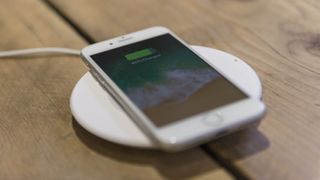Why you can trust TechRadar
- Will last a day – just – on a single charge with careful usage
- Wireless charging is easy and convenient, but slower
- Fast charging is more useful, but requires extra purchases
Apple never reveals the official battery capacities of its phones, and all it has confirmed with regard to the iPhone 8 is that battery life is comparable to the iPhone 7.
Considering the upgraded internals when it comes to processing power, the news that battery life wasn’t being improved on the iPhone 8 was surprising, and disappointing.
However, now that the launch dust has settled, and devices have made their way into the world, it looks like there’s a good reason for Apple not commenting on the battery size in this case – apparently the iPhone 8 actually has a smaller battery than the iPhone 7.

iPhone 8 battery is 1,821mAh, according to teardowns of the smartphone. That's a fair amount smaller than the 1,960mAh power pack inside the iPhone 7.
The good news is that the battery performance of the iPhone 8 is comparable to that of the iPhone 7, even with the smaller battery. The bad news, however, is that the iPhone 7 didn’t exactly dazzle us in this respect.
There were a number of days when we had to top-up our iPhone 8 before we left the office to guarantee the phone lasting until bedtime.
Most days saw us take the iPhone 8 off charge at 7am, followed by around three hours of music streaming, a healthy dose of email, social media and messaging action, along with a handful of calls, an hour of gaming and some web browsing.
This generally saw the iPhone 8 battery reach its end around 9pm – and that included switching on power saving mode at 20% in an attempt to keep it going for longer.
On lighter usage days, with little music streaming or gaming, the iPhone 8 could just about see out a 7am-11pm stretch if we engaged low power mode when we hit around 30%, but if you’re planning to be away from your regular charging spot the entire day we’d recommend taking a cable with you.
The one silver lining here is the inclusion, for the first time on an iPhone, of wireless charging, courtesy of the glass rear on the handset. Wireless charging currently doesn’t work through metal bodies, so a shift to a different material was needed in order to make this happen, and Apple chose super-strength glass.

The iPhone 8 supports the Qi wireless charging standard, which is the most commonly used, meaning there’s already a range of charging pads out there that are compatible.
You may find a charging pad when you’re out and about, with the like of McDonalds and Starbucks starting to build them into counters and tables in their restaurants, while a number of car manufacturers are starting to include wireless charging areas in the cabin.
It’s certainly a convenient way to charge – just place the handset on the pad and it’ll start topping up – but it won’t refuel as quickly as via a wired connection. The iPhone 8 also doesn’t come with a wireless charging pad included in the box, which means it’s an additional cost you’ll have to incur.
Apple offers two AirPower-supported charging pads, from Belkin and Mophie, which will set you back $59.95 / £54.95 / AU$99.95) each – not exactly cheap considering their function.
There are cheaper pads available if you shop around – just make sure they support Qi – although it’s worth noting that the Apple-approved pads offer a higher voltage (7.5w), which means they’ll likely top up your iPhone 8 faster than lower-powered rivals.
That said, if you’re in need of a quick top-up before heading out the door for the night you’ll want to using the Lightning cable which comes in the box, as it’ll give you more juice for your minutes.

John joined TechRadar over a decade ago as Staff Writer for Phones, and over the years has built up a vast knowledge of the tech industry. He's interviewed CEOs from some of the world's biggest tech firms, visited their HQs and has appeared on live TV and radio, including Sky News, BBC News, BBC World News, Al Jazeera, LBC and BBC Radio 4. Originally specializing in phones, tablets and wearables, John is now TechRadar's resident automotive expert, reviewing the latest and greatest EVs and PHEVs on the market. John also looks after the day-to-day running of the site.

I got a Dolby Atmos soundtrack mixing demo at Sony Pictures Studios, and now I know how Spider-Man sounds get made

Today's Wordle answer is the hardest this year, with an average score of 5.4, and 'Wordle 1037 X' is trending on Twitter – here's why it's so tough and what to do in future

JLab JBuds Lux ANC review: budget headphones that are all about that bass
